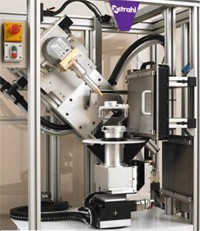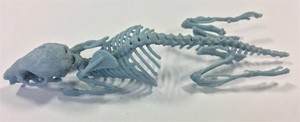Data, data, data: The importance of measurement and the 3Rs

This is the first post in a series of guest blogs about different aspects of managing data and its importance for the 3Rs.
Dr Giuseppe Schettino (pictured) from the National Physical Laboratory (NPL) talks about efforts to reduce the number of animals used in research by increasing the quality and quantity of information gained from every measurement.
Better measurement, better data
The ability to make accurate and precise measurements is one of the foundations of scientific research. Studies using animals inherently require accurate measurements to be taken, be it when administering a treatment, carrying out a procedure or measuring an outcome, in order to maintain scientific rigor and assess welfare endpoints. Better measurement practice leads therefore to better, more reproducible results that are the hallmarks of good science.
In practice, the larger the uncertainty involved in each measurement we make in an experiment, the larger we have to make our sample size to detect biologically-relevant differences. This creates a big opportunity for the measurement science community (researchers developing state-of-the-art measurement techniques and technologies) to get involved in efforts to reduce the number of animals used in research, by improving measurement practice and maximising the information obtained from animal models.
My research at NPL is focused on ensuring radiation doses delivered to patients undergoing radiotherapy are as accurate as possible. Historically, improvements in radiotherapy have been driven by technological leaps in physics and engineering – such as the development of the linear accelerator, now commonly used to deliver beams of radiation to patients undergoing radiotherapy. But as further advances in particle physics get more complex and expensive, any future step-change improvements in the success of radiotherapy are much more likely to come from a better understanding of the biological effects of radiation.
Devil’s in the dose
Consequently, there’s been a considerable increase in the number of radiobiological experiments being carried out on animal models in recent years, with over 2,000 new publications each year (according to the Pubmed search engine). But, despite increased efforts, very few breakthroughs in these preclinical studies are making it through to the clinical stage and going on to benefit patients.
So what’s blocking this pipeline? One of the biggest problems is that, in contrast to clinical practice, there is a lack of standards and guidelines to make sure accurate, consistent doses of radiation are delivered to the animals. Radiobiological studies require a multidisciplinary approach with close collaboration between biologists, chemists and medical physicists, which is not always available in research centres. This leads to measurement uncertainties that seriously undermine the reliability and reproducibility of preclinical radiobiological studies and ultimately means more animals have to be used.
As the UK’s National Measurement Institute, this is exactly the sort of problem we at NPL help academia and industry to overcome. With funding from Innovate UK and the NC3Rs Non-Animal Technologies programme1, we’re establishing new guidelines and a dosimetry service (for measurement of received radiation dose) specifically designed for preclinical radiobiological studies. This project is in collaboration with the University of Hull and Xstrahl, a designer and manufacturer of X-ray therapy systems.

Image: Small Animal Radiation Research Platform, designed to match standard of care for radiation treatments in a pre-clinical setting (Credit: Xstrahl)
This will give researchers access to standardised dosimetry protocols and tools such as a small animal phantom, a specially designed object which reproduces the shape and tissue properties of real animals (see image below), so they know exactly how much radiation they’re delivering to animal models and even where it’s going within their bodies.
3Rs opportunities
NPL’s small animal phantom is a multipurpose 3D-printed model designed to assess the accuracy of dose delivery. Made from tissue-mimicking materials, it can incorporate a bespoke microfluidic device, containing a tissue biopsy, offering an alternative, in vivo-like option for radiation-drug synergistic studies. Using the phantom will reduce the number of animals needed to test specific hypotheses due to the smaller variation in dose-response measurements. By increasing the quality of the information provided by these studies, we aim to significantly reduce the number of animals used and reduce costs. Because tissue is so sensitive to the effects of radiation, tiny variations in the dose delivered can lead to significantly different biological responses that distort results.
And as well as increasing the quality of information we get from animal models, we’re also looking to increase the quantity. My colleagues in the National Centre of Excellence in Mass Spectrometry Imaging at NPL are developing some of the most powerful imaging techniques available to make sure researchers get as much information as possible from every measurement carried out on an animal model.

Image: 3D printed bone equivalent mouse skeleton (Credit: NPL and the University of Hull)
With support from NC3Rs’ CRACK IT Challenges programme (Inhalation Translation), our researchers are demonstrating how mass spectrometry imaging can be used to monitor multiple inhaled drug compounds and their metabolites, as well as identifying molecules associated with drug-induced pathology, in a single experiment, reducing the need for tests on multiple animals. Working in collaboration with pathologists, this information can help us understand if these pathologies are relevant to humans and likely to cause problems in later stage clinical trials; supporting decision makers in earlier go/no-go decisions and preventing drugs which are destined to fail in humans from entering regulatory in vivo studies. Current approaches can use 180 rats or more per study, so this represents a potentially significant reduction in the number of animals – as well as the associated time and costs – used in mechanistic studies in the early stages of drug development.
Looking to the future
For NPL to continue to deliver science with impact, we work in collaboration with partners across industry, academia and government, and our results and the data generated are made as widely available as possible. This is increasingly important in a scientific landscape where multidisciplinary approaches are mandatory, large amounts of data are being generated through a variety of modalities and the quality of the output is directly linked to the quality of the input data. NPL’s access to instrumentation capable of measuring everything from the molecular scale to whole body responses, together with advances in mathematical biology, offers exciting opportunities for the growing scientific field of personalised medicine and adverse outcome pathways (AOPs). Development of mechanistic or pathways-based approaches for radiation, chemicals and pharmaceuticals can predict the likelihood of harmful adverse outcomes for humans and/or the environment. Challenges remain to develop strategies for identification and application of knowledge within AOPs more broadly across medical environments.
The rapid expansion of data generation across multiple sectors has led NPL, working with collaborators, to instigate an increased focus on understanding data quality and uncertainty. For example, we are investigating reliable methods of combining different data types, converting data into formats suitable for rapid analysis without losing information, and how uncertainties propagate through data analysis.
Read more: npl.co.uk/preclinical-dosimetry
1Funders of the Non-Animal Technologies programme: Innovate UK, NC3Rs, DSTL, BBSRC, MRC, EPSRC
About the National Physical Laboratory
The National Physical Laboratory (NPL) is the UK’s National Measurement Institute and the birthplace of Alan Turing’s ACE computer, the first universal computer of its kind; packet switching, the basis of the internet; and atomic time, the backbone of GPS and global communications.
Our measurement expertise has underpinned prosperity and quality of life in the UK for more than a century. Our role is highly diverse and finds us working on world-leading science and engineering that impacts healthcare, environmental monitoring, advanced manufacturing and the development of next-generation technologies and techniques, with the potential to further transform our lives; from new antibiotics to tackle resistance and more effective cancer treatments, to unhackable quantum communications and superfast 5G.
Based in Teddington, south-west London, NPL employs over 500 scientists and is home to 388 of the world’s most extensive and sophisticated measurement science laboratories.
